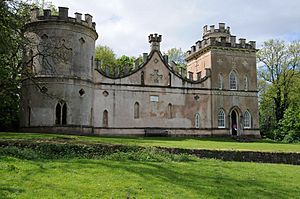Clytha Castle facts for kids
Quick facts for kids Clytha Castle |
|
|---|---|

"the Taj Mahal of Wales"
|
|
| Type | Folly |
| Location | Clytha, Monmouthshire |
| Built | 1790 |
| Architect | John Davenport |
| Architectural style(s) | Strawberry Hill Gothick |
| Governing body | Landmark Trust |
|
Listed Building – Grade I
|
|
| Official name: Clytha Castle | |
| Designated | 9 January 1956 |
| Reference no. | 1968 |
| Lua error in Module:Location_map at line 420: attempt to index field 'wikibase' (a nil value). | |
Clytha Castle (Welsh: Castell Cleidda) is a special kind of building called a folly. It's located near Clytha in Monmouthshire, south east Wales. A folly is a building made to look like something grand, but it doesn't have a real purpose like a normal castle.
This castle was built in 1790 by William Jones. He owned the Clytha Park estate. He built it as a memorial to his wife, Elizabeth, who passed away in 1787. Clytha Castle is a great example of the Gothic Revival style. This means it looks like old Gothic castles from the Middle Ages. It has three towers, and two of them can be lived in. It also has connecting walls with battlements, like a real castle.
For a long time, people thought a famous architect named John Nash designed it. But new research shows that John Davenport from Shrewsbury was the real architect. The castle offers amazing views of the Sugar Loaf and Skirrid mountains. These mountains are on the edge of the Brecon Beacons National Park. An expert named John Newman said Clytha Castle is one of the best examples of "fanciful Gothic" buildings from the late 1700s in the area. It is also a Grade I listed building, which means it's a very important historic building.
Where is Clytha Castle?
Clytha Castle is found near the A40 road, which goes from Abergavenny to Raglan. It was once part of the large parkland of Clytha Park. This park is about four miles west of Raglan.
The castle's location gives "magnificent views" across the valley. You can see the Skirrid and Sugar Loaf Mountains from there.
History and Design
Clytha Castle is a stone folly with crenellated walls, which means it has battlements like a castle. It also has Gothic-style windows. It sits on a round hill, surrounded by chestnut trees. From here, you can look down over Clytha Park and the River Usk.
William Jones of Clytha Park built it in 1790. He wanted to remember his wife, Elizabeth Morgan. William Jones hired John Davenport, an architect from Shrewsbury, to design the castle. He built it "for the purpose of relieving a mind sincerely afflicted by the loss of a most excellent wife." This means he built it to help him feel better after losing his wife. A special stone tablet inside the castle tells this story.
For many years, people thought the famous architect John Nash designed the castle. But recent studies have shown that John Davenport was the true designer.
Experts on follies, Gwyn Headley and Wim Meulenkamp, said Clytha Castle's style is like a "late fling of Strawberry Hill Gothick." They even called the building "the Taj Mahal of Wales." The Taj Mahal is a famous memorial in India. John Newman, another expert, believes it's one of the best examples of "fanciful Gothic" buildings from the late 1700s in the county.
The castle is made of stone rubble covered in a special plaster, with details made from Bath stone. It has an L-shape, with a square, two-story main part. On each side, there are screen walls and round towers. The way the building is shaped and where it's placed makes it a great "eyecatcher." This means it's designed to look impressive from a distance. The round tower doesn't have a roof. It was built this way to make the front of the castle look balanced.
A gardener and historian named John Claudius Loudon wasn't very impressed. He called the folly "gaudy and affectedly common." However, the official listing from Cadw (the Welsh government's historic environment service) says Clytha Castle is "one of the outstanding 18th century follies of Wales."
Today, Clytha Castle is looked after by the Landmark Trust. They have taken care of the building since 1974. You can even rent it out to stay there!

